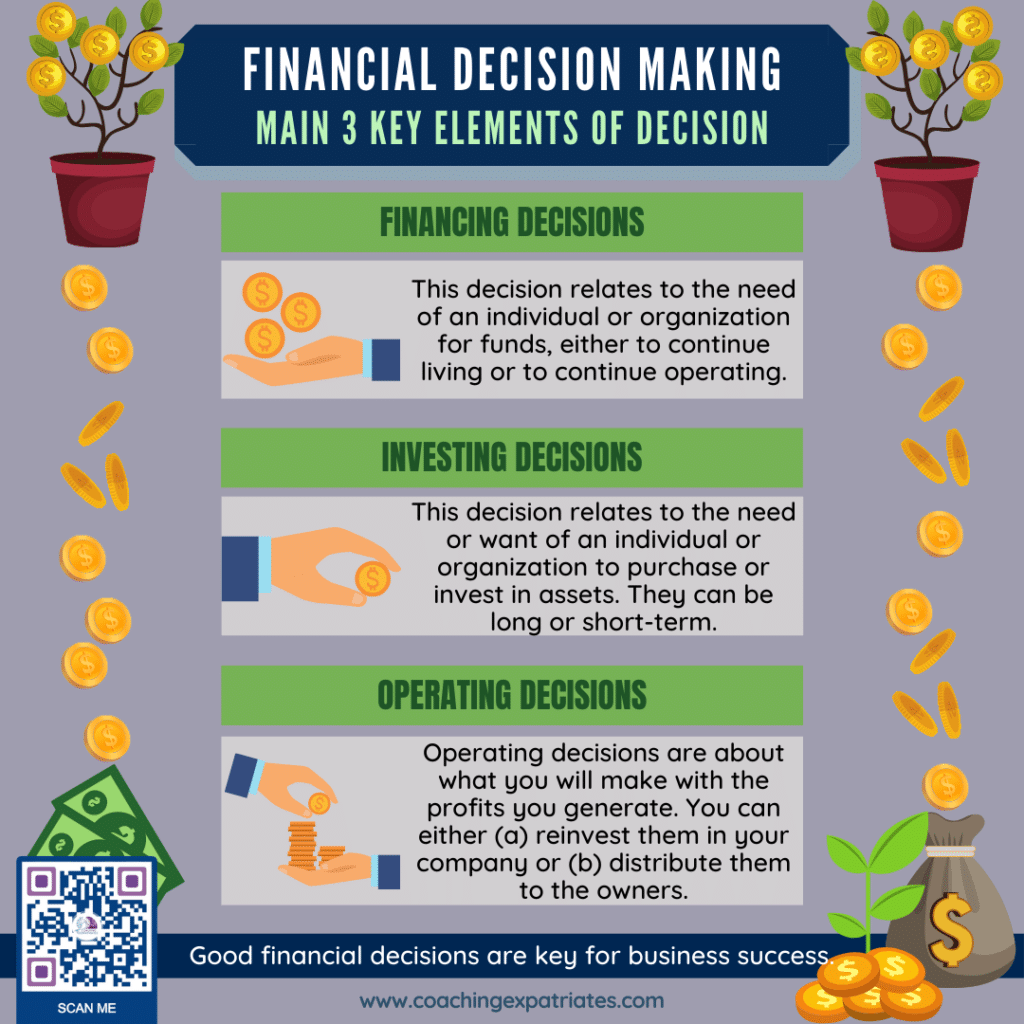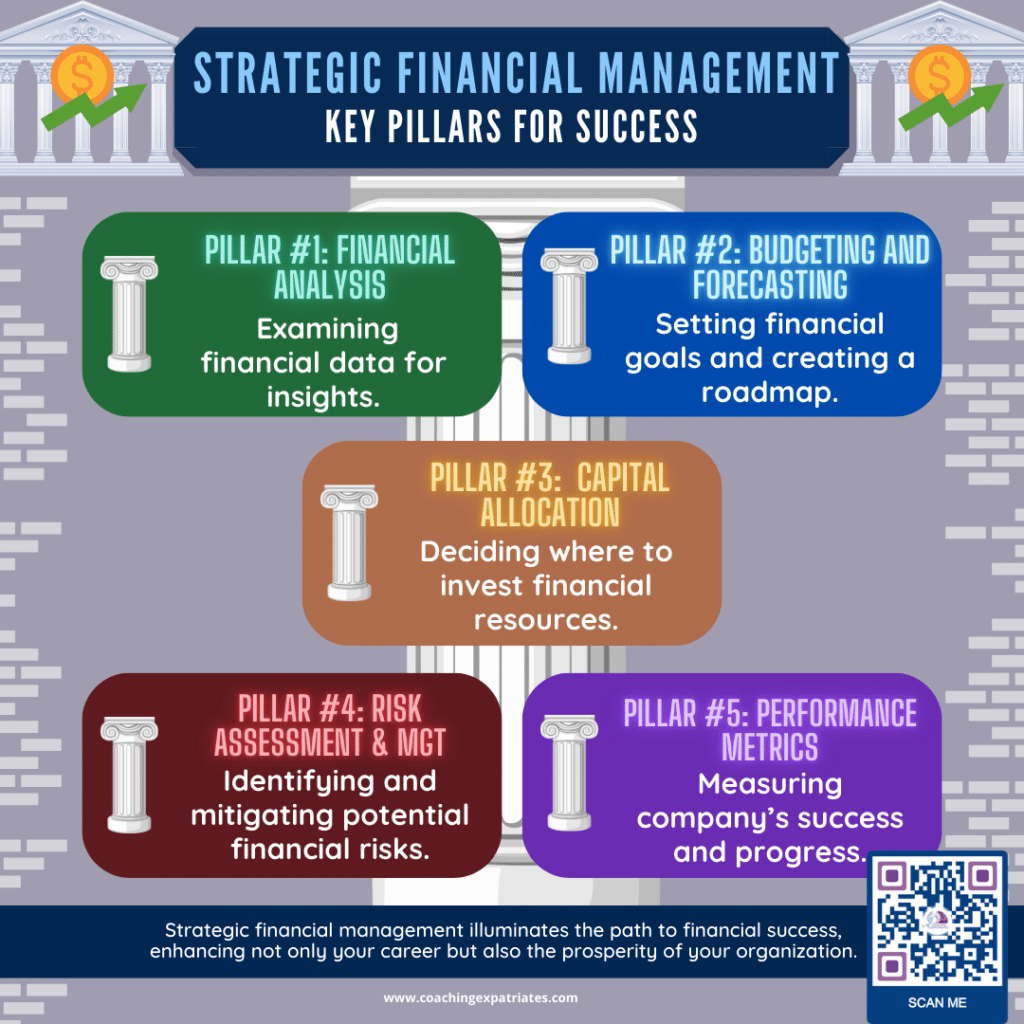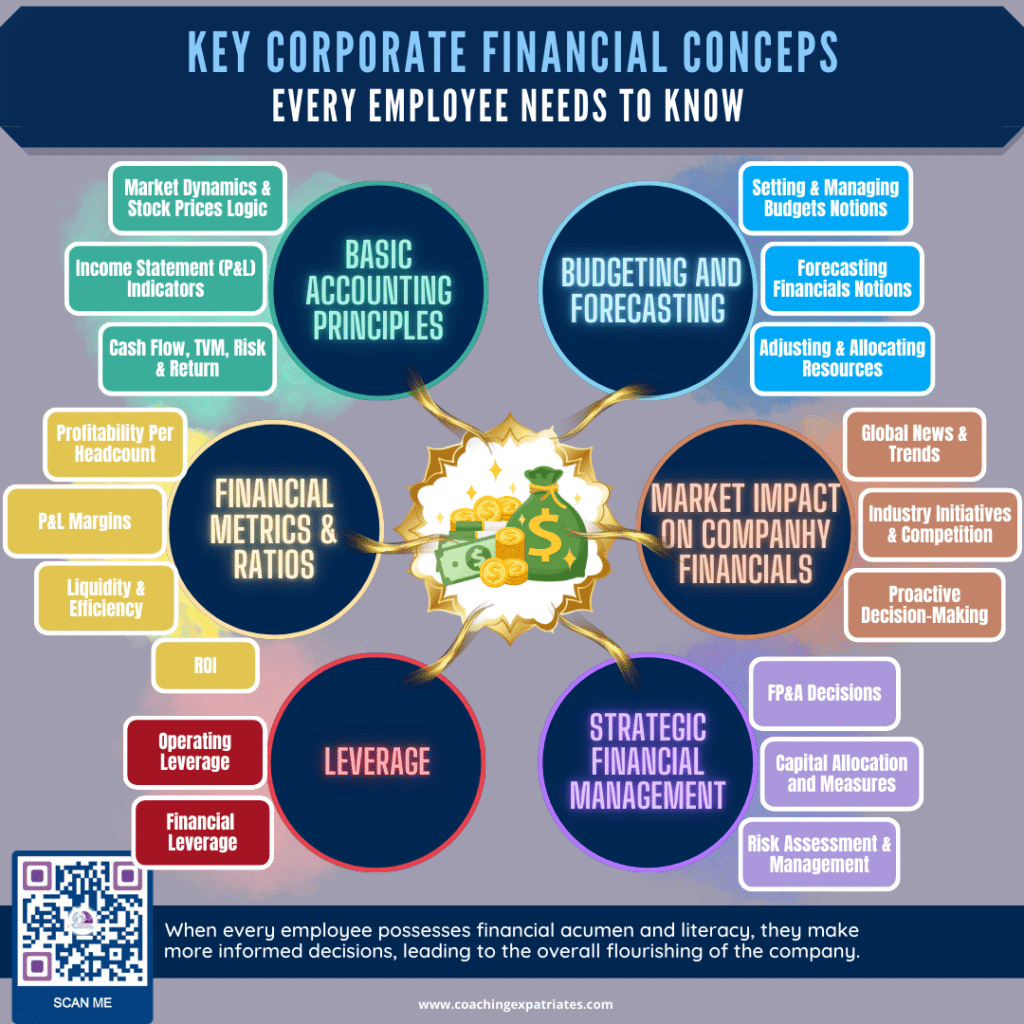Did you know that 67% of financial decisions in businesses are influenced by employees with strong financial acumen? This statistic, highlighted in a report by Deloitte, underscores the critical role that financial knowledge plays in the global workplace. [source: Deloitte’s Global Human Capital Trends report, 2021.] As global businesses navigate complex financial landscapes, the importance of financial acumen among executives and all employees becomes increasingly evident. Yep, I’m not talking about CFOs or finance executives and employees. I am talking about any employee in any department and any level in the company. If you work for any corporation, no matter what job you hold, this article is definitely for you.
Think you have what it takes to decide... like a boss? Take the quiz and find out!
Executive Edge: How Sharp Is Your Corporate Finance IQ?
Complete the quiz to receive personalized recommendations tailored to your finance acumen score, and unlock a comprehensive PDF e-Book filled with over 40 pages of essential financial concepts and infographics. Elevate your financial acumen and gain the edge you need to lead with confidence!
TAKE QUIZThe Importance Of Financial Acumen In The Workplace
Financial acumen refers to the understanding of financial principles and the ability to apply this knowledge to make sound business decisions. It’s an important aspect of business acumen for any executive. It’s not just about numbers; it’s about comprehending how financial decisions impact the overall health of an organization. Employees with strong financial acumen can interpret financial statements, understand market trends, and contribute to strategic planning. This expertise helps identify opportunities for growth, mitigate risks, and ensure the efficient allocation of resources. In essence, a workforce with robust financial knowledge is better equipped to drive a company towards its goals and sustain its competitive edge.

The Role Of HR In Enhancing Financial Knowledge
Human Resources (HR) plays a pivotal role in fostering financial acumen within an organization. As the department responsible for employee development and training, HR can implement comprehensive financial training programs tailored to different levels of the organization. By identifying skill gaps and providing relevant resources, HR can ensure that employees—from entry-level to executive—are equipped with the necessary financial skills.
Moreover, HR can promote a culture of continuous learning, encouraging employees to stay updated with the latest financial trends and practices. This proactive approach not only enhances individual performance but also contributes to the organization’s overall success. By prioritizing financial training, HR can help create a knowledgeable, confident, and agile workforce capable of navigating the complexities of the modern business environment.
In this blog post, we will explore the essential financial concepts every employee should know and discuss how HR can effectively train and support their team in developing these crucial skills.
Understanding Financial Acumen
Recently, many HR and top executives have come to our coaching sessions with strategic hot potatoes that are challenging to tackle. One competency stands out as a pivotal driver of organizational success: financial acumen. But what exactly does financial acumen entail, and why is it crucial for every employee within your organization?
What Is Financial Acumen?
Financial acumen refers to the ability to understand and apply financial principles and concepts in making business decisions. It encompasses a range of skills, including the ability to understand basic financial principles, manage expenses and budgets efficiently, optimize resource allocation, and make informed financial decisions that align with the strategic goals of the company.
For HR executives and senior leaders, cultivating financial acumen within your teams is not just about numbers; it’s about empowering your employees with the knowledge to contribute meaningfully to the organization’s financial health.

Why Is Financial Acumen Crucial For Every Employee?
- Informed Decision-Making: Employees with strong financial acumen can make more informed decisions that positively impact the company’s bottom line. They understand how their actions affect the financial outcomes and can prioritize initiatives that drive growth and efficiency.
- Enhanced Strategic Alignment: When employees understand financial metrics and their implications, they are better equipped to align their actions with the company’s strategic objectives. This alignment fosters a cohesive effort towards achieving long-term goals.
- Improved Resource Management: Financially savvy employees are adept at managing resources efficiently. They can identify cost-saving opportunities, optimize spending, and contribute to financial planning processes that ensure sustainability and profitability.
- Risk Mitigation: Understanding financial risks and their potential impact on the business enables employees to take proactive measures to mitigate these risks. This foresight can protect the organization from unexpected financial setbacks.
- Increased Accountability: Financially literate employees take ownership of their roles in the financial health of the organization. This accountability drives a culture of responsibility and transparency, where everyone works towards common financial goals.
As HR leaders and senior executives, your role in fostering financial acumen cannot be overstated. It involves not only providing the necessary training and resources but also creating an environment where financial literacy is valued and encouraged.
Key Financial Concepts Every Employee Should Know
The world of corporate finance is extensive and complex, often challenging to navigate without formal education. However, when employees across all levels understand and apply key financial concepts in their daily work, both their careers and the company benefit significantly. This financial knowledge empowers employees to make informed decisions, enhancing their reputation and increasing their chances for promotions. Simultaneously, it drives the company’s success by fostering sound financial practices and strategic growth.
Importantly, anyone can learn these basic concepts through informal education, such as this article and other resources that we will share at the end. It is not necessary to have a finance MBA to apply financial concepts effectively for a successful career.
It just takes some time, effort, and good resources to do so. In this article, I aim to provide a checklist for HR professionals and global executives—not only to guide their own learning in financial acumen but also to ensure they are equipping their employees with the necessary training and resources. Before diving in, take our FINANCE QUIZ to evaluate your current level of financial acumen. It will help you identify areas where you might need further learning and development.
Let’s explore these essential financial concepts.

1. Basic Accounting Principles
A solid foundation in accounting principles is essential for every employee, regardless of their role within the company. Understanding these principles helps in grasping the broader financial picture and making informed decisions that contribute to the organization’s success.
Market Dynamics And Stock Prices: Understanding Investor Impact On Company Value
The stock market plays a significant role in shaping a company’s financial health. When investors buy and sell stocks, they affect the company’s market value. High demand for a company’s shares generally increases its stock price, which can be indicative of investor confidence and future growth potential. Conversely, a declining stock price may signal investor concerns or broader market challenges.
Employees should understand how market dynamics influence stock prices and, consequently, the company’s valuation. This knowledge is crucial for those involved in strategic planning, investor relations, and even daily operations, as it impacts the company’s ability to raise capital, invest in new projects, and reward shareholders.
Income Statement: What Is P&L And Its Main Indicators?
The income statement, an important financial report often referred to as the profit and loss (P&L) statement, provides a summary of a company’s revenues, costs, and expenses over a specific period. It is a key financial document that highlights the company’s operational efficiency and profitability.
Key indicators on the income statement include:
- Revenue: Total income generated from sales of goods or services.
- Cost of Goods Sold (COGS): Direct costs attributable to the production of the goods sold by the company.
- Gross Profit: Revenue minus COGS, indicating the company’s efficiency in producing goods.
- Operating Expenses: Costs associated with running the business, such as salaries, rent, and utilities.
- Operating Income: Gross profit minus operating expenses, showing the company’s profit from regular business operations.
- Net Income: The final profit after all expenses, taxes, and interest have been deducted from total revenue. It represents the company’s overall profitability.
Understanding the P&L statement helps employees gauge the company’s financial performance and identify areas for improvement.
Why Cash Is King?
Cash flow is the lifeblood of any business, and it is officially represented through the Cash Flow Statement, another financial report. It represents the money moving in and out of the company and is crucial for maintaining daily operations, paying employees, and investing in growth opportunities.
The phrase “cash is king” underscores the importance of liquidity. Unlike profits recorded on an income statement, cash flow indicates the actual cash available to meet obligations and seize new opportunities. Positive cash flow ensures that a company can sustain its operations and weather financial downturns, while negative cash flow can lead to severe operational challenges and even bankruptcy.
Key components of cash flow and financial decision-making include:
- Operating Cash Flow: Cash generated from the company’s core business activities.
- Investing Cash Flow: Cash used for or generated from investments in assets, such as property or equipment.
- Financing Cash Flow: Cash received from or paid to investors and creditors, such as issuing stock or repaying loans.

Employees should recognize the importance of managing cash flow effectively to ensure the company’s stability and growth. Understanding these basic accounting principles empowers employees to contribute to the financial health and strategic direction of the organization.
Time Value Of Money: Why A Dollar Today Is Worth More Than A Dollar Tomorrow
The concept of Time Value of Money (TVM) is a cornerstone of financial literacy. It posits that a dollar today is worth more than a dollar in the future due to its potential earning capacity. This principle is fundamental in finance, as it underpins the idea that money can grow over time through investments or interest.
For instance, when I lived in Brazil back in the 1980s, the country was experiencing extraordinarily high inflation rates. Many businesses took advantage of this situation by engaging in financial operations designed to capitalize on the high inflation and the lucrative investment returns available at the time. These businesses thrived in an environment where money rapidly depreciated, but investment returns were substantial, allowing them to profit from the volatility.
However, this reliance on inflation-driven returns proved perilous. When Plano Real was implemented—a new currency plan that brought hyperinflation under control—many businesses found themselves unprepared for the drastic change. Overnight, their financial strategies became obsolete, and without the high returns they had come to depend on, many businesses went bankrupt. This example underscores the importance of understanding TVM and the risks associated with relying too heavily on volatile economic conditions.
For business leaders, understanding TVM is crucial in making decisions that impact the company’s financial health. Here’s why:
- Investment Decisions: When evaluating projects, companies must consider not just the future cash flows but also their present value. This helps in determining whether an investment is worthwhile.
- Discounted Cash Flow (DCF) Analysis: A method that applies the TVM concept to estimate the value of an investment, taking into account the expected cash flows and the time at which they will occur.
- Loan and Financing Costs: The cost of borrowing money is also influenced by TVM. Companies need to factor in the interest that will accumulate over time.
By mastering the concept of Time Value of Money, executives can make better-informed decisions that optimize financial outcomes and contribute to the long-term success of the business.
Risk And Return: Balancing Profit Potential And Uncertainty
Understanding the relationship between risk and return is crucial for making informed financial decisions. In simple terms, risk refers to the possibility of losing money on an investment, while return represents the profit or loss derived from an investment over a period. The principle of risk and return suggests that higher potential returns are usually associated with higher levels of risk.
For companies, managing this balance is essential. All types of decision-makers must assess how much risk they are willing to take in pursuit of higher returns, whether it’s through investments in new projects, entering new markets, or even managing the company’s debt levels. A few key considerations include:
- Risk Appetite: How much uncertainty can decision-makers navigate while aligning with the risk tolerance of investors and owners, ensuring the company’s financial stability remains intact?
- Diversification: Spreading investments across various assets to minimize risk.
- Expected Return: Estimating the potential profit from an investment, considering the associated risks.
Executives need to weigh these factors to make choices that align with the company’s long-term financial goals. Understanding this balance not only helps in safeguarding assets but also in driving sustainable growth.
For example, I once worked with a global CEO who was keen on making a divestiture of a product line that was the least profitable in our portfolio. A divestiture, in this context, refers to the process of selling off a business unit, product line, or other assets to streamline operations or focus on more profitable areas. His intention to divest was logically sound—this product line was indeed dragging down the average profitability of our product mix. However, where he faltered was in not fully considering the relationship between risk and return.
This particular product line was inherently riskier, making it less attractive to potential buyers. As a result, it was unrealistic to expect a high return from selling it. Yet, the CEO was fixated on achieving a high sale price, which led to repeated failures in divestiture attempts year over year. This misalignment between expectations and the actual risk-return profile of the product line negatively impacted employee morale, disrupted operations, and even tarnished our market reputation for this product line.
This experience underscores the importance of aligning executive expectations with reality. Not understanding basic risk and return—even in cases that seem straightforward—can jeopardize not only a business but also your career. Executives must be vigilant in ensuring that their strategies reflect a clear understanding of the risks involved and the realistic returns those risks can generate.
2. Budgeting And Forecasting
Effective budgeting and forecasting are essential for ensuring an organization’s financial health and strategic success. They help in setting financial goals, allocating resources efficiently, and preparing for future uncertainties.
Importance Of Budgeting
Budgeting is a critical financial management tool that helps organizations plan and control their finances. It involves outlining expected revenues and expenses over a specific period, allowing businesses to allocate resources strategically and ensure financial stability. The importance of budgeting includes:
- Financial Control: Budgets provide a framework for managing finances, preventing overspending, and ensuring that funds are available for essential operations and projects.
- Goal Setting: By setting financial targets, budgets help align organizational objectives with available resources, facilitating the achievement of strategic goals.
- Performance Measurement: Budgets serve as a benchmark for evaluating actual financial performance against projected figures, helping identify areas that need improvement.
- Resource Allocation: Budgeting ensures that resources are allocated to the most critical areas, optimizing the use of available funds.
- Risk Management: A well-prepared budget can help anticipate financial challenges and prepare contingency plans, reducing the impact of unexpected events.
Creating And Managing A Budget
Creating and managing a budget involves several steps that ensure it is realistic, comprehensive, and aligned with organizational goals.
- Setting Objectives: Begin by defining the financial and strategic objectives the budget aims to achieve. These objectives should align with the overall goals of the organization.
- Gathering Information: Collect historical financial data, market trends, and business forecasts to create a realistic budget. This data provides a baseline for projecting future revenues and expenses.
- Estimating Revenues: Forecast future revenues based on historical data, market analysis, and business strategies. Consider factors such as sales trends, pricing strategies, and market conditions.
- Projecting Expenses: Identify and estimate all expected expenses, including fixed costs (e.g., rent, salaries) and variable costs (e.g., materials, utilities). Be sure to account for potential changes in costs due to inflation or business growth.
- Allocating Resources: Allocate funds to different departments and projects based on their importance and contribution to the organization’s goals. Ensure that critical areas receive adequate funding.
- Monitoring and Adjusting: Regularly review actual financial performance against the budgeted figures. Identify variances and understand their causes. Adjust the budget as needed to reflect changes in the business environment or organizational priorities.
- Involving Stakeholders: Engage key stakeholders, such as department heads and financial managers, in the budgeting process. Their input and buy-in are crucial for creating a realistic and achievable budget.
- Communicating the Budget: Clearly communicate the budget to all relevant parties within the organization. Ensure that everyone understands their roles and responsibilities in achieving the budgeted targets.

By effectively creating and managing a budget, organizations can ensure financial discipline, make informed decisions, and position themselves for long-term success. Budgeting and forecasting are not just financial exercises; they are strategic tools that drive organizational performance and growth.
3. Financial Metrics And Ratios
Understanding financial metrics and ratios is crucial for employees at all levels, as these indicators provide insights into the company’s financial health and operational efficiency. Key metrics and ratios that every employee should be familiar with include profitability per headcount, P&L margins, liquidity ratios, and efficiency ratios.
Profitability Per Headcount
Profitability per headcount is a significant metric that measures the profit generated by each employee. It is calculated by dividing the company’s net profit by the total number of employees. This ratio provides insights into how effectively a company is utilizing its workforce to generate profit.
- Impact on Hiring and Layoffs: Companies closely monitor this metric to make strategic decisions about staffing. A high profitability per headcount indicates efficient use of human resources, while a low ratio may signal inefficiencies. This is one reason why getting new headcount approved can be challenging, as companies aim to maintain or improve this ratio. Conversely, extensive layoffs might occur to improve this metric, signaling to the market and investors that the company is focused on maintaining profitability.
Return On Investment (ROI)
Return on Investment (ROI) is a key financial metric used to evaluate the efficiency of an investment. It is calculated by dividing the net profit from an investment by the initial cost of the investment, then multiplying the result by 100 to get a percentage. This ratio indicates how effectively a company is generating profits relative to the money invested.
Decision-Making And Strategy: ROI plays a crucial role in decision-making, as it helps executives assess the potential return on various projects, initiatives, or acquisitions. A higher ROI indicates that an investment is generating substantial returns relative to its cost, making it a favorable choice for resource allocation. On the other hand, a low ROI may prompt a company to reconsider or abandon certain investments, as they may not be delivering adequate returns. For example, many HR departments are increasingly pressured to demonstrate the ROI of their coaching and training programs. Executives often want to see tangible proof that these initiatives are contributing positively to the company’s bottom line before continuing or expanding them.
To support HR professionals in this challenge, we’ve developed a comprehensive white paper that spans over 60 pages, filled with in-depth research, strategies, and case studies on how to accurately measure and communicate the ROI of coaching and training programs. Download our white paper to gain the insights you need to effectively showcase the value of these essential programs.
Benchmarking And Performance: Companies also use ROI to benchmark the performance of different investments, comparing them to industry standards or historical performance. This helps in identifying which areas are most profitable and deserve more attention or resources. It also aids in performance evaluation, ensuring that investments are aligned with the company’s strategic objectives and financial goals. For instance, at Coaching Expatriates®, we closely monitor the ROI of our customer acquisition efforts. If an investment does not yield more than a 75% ROI, we are currently exploring other customer acquisition strategies. This approach stems from the understanding that customer acquisition costs for service-based companies, while not formally classified as direct costs, are functionally similar to the cost of goods sold (COGS) in manufacturing companies. By ensuring that the return on these investments is high, we can maintain stronger margins in our operations, which is crucial for the overall profitability of the business.
Investor Confidence: A strong ROI can also enhance investor confidence, signaling that the company is capable of making profitable investment decisions. This is particularly important when seeking additional funding or justifying major financial decisions to shareholders. A clear, favorable ROI demonstrates that the company is managing its resources wisely and is committed to delivering value to its investors.
P&L Margins
P&L margins, or profit and loss margins, refer to the ratios that express the relationship between various elements of the income statement and the company’s revenue. Key P&L margins include:
- Gross Profit Margin: Indicates the percentage of revenue that exceeds the cost of goods sold (COGS) or cost of services (COS). It measures how efficiently a company is producing its goods or rendering its services. Additionally, understanding the product mix margin—how different products or services contribute to the overall gross margin—is crucial. A higher gross margin on certain products can offset lower gross margins on others, and employees should be aware of how their role contributes to optimizing this mix. Ensuring a favorable product mix margin is key to sustaining overall profitability and strategic pricing decisions.
- Operating Margin: Shows the percentage of revenue left after covering operating expenses. It reflects the company’s operational efficiency.
- Net Profit Margin: Represents the percentage of revenue that remains as profit after all expenses, taxes, and interest are deducted.
The market closely monitors these margins to gauge a company’s profitability. Higher margins generally indicate a more profitable and efficiently run business, attracting investor confidence and potentially boosting stock prices. Additionally, the market compares these ratios with the market’s average ratios to determine if the company is above or below market management efficiency. Companies with margins that exceed the market average are often seen as better-managed and more attractive investment opportunities.
Liquidity Ratios
Liquidity ratios measure a company’s ability to meet its short-term obligations and are crucial indicators of financial stability. Key liquidity ratios include:
- Current Ratio: Calculated by dividing current assets by current liabilities. A ratio above 1 indicates that the company can cover its short-term debts.
- Quick Ratio: Similar to the current ratio but excludes inventory from current assets. It provides a more stringent measure of liquidity.
- Impact on Business Decisions: When liquidity is high, companies are more likely to approve initiatives such as expansion projects, hiring, and employee travel. Conversely, low liquidity can lead to mandates like hiring freezes, travel freezes, and other cost-cutting measures to preserve cash flow.

Efficiency Ratios
Efficiency ratios assess how effectively a company utilizes its assets and manages its operations. Key efficiency ratios include:
- Asset Turnover Ratio: Measures how efficiently a company uses its assets to generate sales. It is calculated by dividing net sales by average total assets.
- Inventory Turnover Ratio: Indicates how quickly a company sells and replaces its inventory. It is calculated by dividing COGS by average inventory.
- Return On Investment: Though more commonly classified as a profitability metric, it also provides insight into how efficiently a company is using its resources to generate profit (or benefit) from its investments. In this sense, ROI can be seen as a broader efficiency indicator, reflecting how effectively a company converts its investment into profitable returns.
These ratios help in evaluating the effectiveness of a company’s operational management. High-efficiency ratios suggest that the company is using its resources well to generate sales and manage inventory, contributing to overall profitability and operational health.
Understanding these financial metrics and ratios allows employees to better comprehend the company’s financial position and the rationale behind strategic decisions. This knowledge empowers them to contribute more effectively to the organization’s financial success and operational efficiency.
4. Leverage: Maximizing Financial Potential
Leverage is a powerful financial concept that plays a crucial role in maximizing a company’s potential and achieving strategic objectives. It involves using borrowed capital or debt to increase the potential return on investment. By effectively utilizing leverage, companies can amplify their financial resources and enhance their ability to invest in growth opportunities.
Understanding Leverage
Leverage allows a company to use various forms of debt (such as loans or bonds) to finance its operations and investments, rather than relying solely on equity or internal funds. This approach can significantly boost the company’s ability to invest in new projects, expand operations, or enter new markets.
Types Of Leverage
Operating Leverage: This occurs when a company uses fixed costs to generate higher profits. Higher operating leverage means that a company can increase its profits from incremental sales without a corresponding increase in operating costs.
Financial Leverage: This involves using borrowed funds to finance the acquisition of assets. The goal is to earn a higher return on investment than the cost of borrowing.
Benefits Of Leverage
- Increased Investment Capacity: Leverage enables companies to undertake larger projects and investments that they could not afford with just their own funds.
- Potential for Higher Returns: By using borrowed funds, companies can potentially achieve higher returns on equity. This is because they are able to generate returns on a larger amount of capital than they could with equity alone.
- Tax Advantages: Interest payments on debt are often tax-deductible, reducing the overall tax burden for the company.
Risks Of Leverage
- Increased Risk: While leverage can amplify returns, it also amplifies losses. If investments do not perform as expected, the company still needs to meet its debt obligations, which can lead to financial distress.
- Cash Flow Pressure: Regular interest payments can strain the company’s cash flow, especially if revenues are lower than anticipated.
Leverage In Strategic Financial Management
Leverage is a key component of strategic financial management. It is intertwined with other financial concepts such as financial analysis, budgeting, and risk management. Top executives must carefully assess the level of leverage appropriate for their company, balancing the potential for higher returns with the associated risks.
By mastering leverage and other financial principles, executives can make informed decisions that enhance the company’s financial stability and growth potential. As Robert Kiyosaki aptly stated, “The most important word in the world of money is cash flow. The second most important word is leverage.” Understanding and effectively utilizing leverage is essential for driving business success and maximizing financial potential.

5. Strategic Financial Management
Strategic financial management involves the comprehensive planning and controlling of financial resources to achieve the organization’s long-term objectives. It encompasses various key areas that ensure the company’s financial stability and growth. Here are the five pillars of strategic financial management:
- Financial Analysis: Examining financial data for insights, which is one of the tasks within financial planning and analysis (FP&A). Every employee should partner with someone in FP&A to help them make better financial analyses and decisions.
- Budgeting And Forecasting: Tasks within financial planning and analysis (FP&A) that involve setting financial goals and creating a roadmap. Every employee should partner with someone in FP&A to help them make better financial budgets, forecasts, and decisions.
- Capital Allocation: Deciding where to invest financial resources.
- Risk Assessment and Management: Identifying and mitigating potential financial risks.
- Performance Metrics: It is critical to measure a company’s success and progress by tracking performance and ensuring alignment with strategic goals.
These five pillars leverage the key financial concepts shared in previous sections, combining and integrating them to facilitate strategic financial planning. The ability to mix and mash these elements is a critical skill that top successful executives possess, enabling them to make informed decisions and steer their companies towards sustained success. Read our dedicated Strategic Financial Management blog post guide for in-depth advanced details.

6. Market Impact On Company Financials: The Need For Executive Vigilance
Understanding how market dynamics impact a company’s financials is crucial for maintaining financial stability and growth. Top executives must stay attuned to global news, trends, and industry initiatives to navigate the complex and ever-changing market landscape effectively.
Global News And Trends
Global news and trends can significantly affect a company’s financial health. Economic shifts, geopolitical events, technological advancements, and changes in consumer behavior can all influence market conditions. For instance, an economic downturn in a key market can lead to reduced consumer spending, affecting sales and revenue. Similarly, geopolitical tensions can disrupt supply chains, leading to increased costs and operational challenges.
Stay informed on global news, trends, and insights, while raising your executive presence through bite-sized global leadership lessons with my weekly newsletter. Subscribe today and become the global executive who’s always ahead of the curve.
Industry Initiatives And Competitive Landscape
Staying informed about industry initiatives and the competitive landscape is equally important. Innovations, regulatory changes, and strategic moves by competitors can create opportunities or pose threats. Executives need to be proactive in adapting to these changes, ensuring that their companies remain competitive and compliant with new regulations.
Proactive Decision-Making
Executives not only need to stay informed but also act swiftly to shield their company’s financials from market uncertainties, if they want to build trust with their board members. This proactive approach involves several key actions:
- Risk Management: Identifying potential risks and developing strategies to mitigate them. This can include diversifying supply chains, securing alternative revenue streams, and maintaining robust financial reserves.
- Strategic Planning: Adjusting business strategies in response to market changes. This might involve shifting focus to emerging markets, investing in new technologies, or reevaluating product lines to align with consumer preferences.
- Cost Control: Implementing cost-saving measures to maintain profitability during market fluctuations. This can include optimizing operations, renegotiating contracts, and implementing efficiency improvements.
- Communication: Keeping stakeholders informed about market conditions and the company’s response. Transparent communication helps build trust, avoids misunderstandings and miscommunication, and ensures that employees, investors, and partners are aligned with the company’s strategic direction.

Importance Of Vigilance
Executives must be vigilant and agile in their decision-making processes. By staying tuned to market developments and their financial impact and responding promptly, they can preemptively address challenges and seize opportunities, ensuring the company’s financial resilience and long-term success.
In summary, the ability to understand and respond to market impacts is a critical skill for top executives. It enables them to protect their company’s financial health, adapt to changing conditions, and maintain a competitive edge in the global market.

The Role Of HR In Training Employees
HR plays a pivotal role in developing employees’ financial acumen, which is essential for informed decision-making and overall organizational success. Here’s how HR can effectively train employees in financial knowledge:
STEP 1: Identifying Training Needs
Assessing Current Financial Knowledge
The first step in enhancing financial acumen is to assess the current level of financial knowledge among employees. HR can conduct surveys, interviews, and assessments to understand the existing gaps in financial understanding. This assessment helps in identifying which areas need improvement and which employees require the most attention.
Setting Training Goals
Once the current financial knowledge is assessed, HR should set clear, achievable training goals. These goals should align with the company’s strategic objectives and address the identified knowledge gaps. For example, goals might include improving understanding of financial statements, enhancing budgeting skills, or increasing awareness of market dynamics.
STEP 2: Designing Effective Training Programs
In-House Training vs. External Courses
HR must decide between in-house training programs and external courses. In-house training allows for customization to the company’s specific needs and culture. It also fosters a sense of unity and shared learning among employees. On the other hand, external courses can provide access to specialized knowledge and broader perspectives from industry experts.
Interactive And Practical Training Methods
Effective financial training should be interactive and practical. Hands-on activities, such as case studies, simulations, and real-world scenarios, help employees apply theoretical knowledge to practical situations. Workshops, role-playing, and group discussions can also enhance engagement and retention of financial concepts. Each employee learns differently. Map your workforce generation pool and how they like to learn when planning your training format.
STEP 3: Utilizing Technology And Tools
Financial Training Software
Leveraging financial training software can provide employees with interactive learning experiences. These tools often include simulations, quizzes, and progress tracking, making learning more engaging and measurable. Financial training software can be customized to fit the specific needs of the organization.
Online Courses And Webinars
Online courses and webinars offer flexibility and access to a wide range of financial topics. They allow employees to learn at their own pace and on their own schedule. Webinars can also provide opportunities for live interaction with experts, adding value to the learning experience.
Many online courses, like The Global Leadership Pillars®, contain not only financial concepts training but also simulations, quizzes, gamification, and discussions to help employees feel engaged while learning. Consider including all these dimensions when designing or hiring training and workshops for your workforce.
Executive Coaching And Group Discussions
For senior leaders and executives, personalized coaching and group discussions can be highly effective. Executive coaching provides tailored guidance to address specific financial challenges and goals. Group discussions among leaders, led by an experienced executive coach with financial acumen, can foster collaborative learning and strategic thinking, helping to align financial acumen with business objectives. For instance, one of my clients enlisted me as her executive coach to develop a set of precise decision-making criteria for her department’s financial strategies. She aimed to align her financial decisions with the overarching company goals while ensuring that these decisions remained consistent and methodical through a formalized decision-making framework.

STEP 4: Measuring The Impact Of Financial Training
For more details, strategies, and tools for measuring the return on investment in your training and coaching initiatives, download our in-depth white paper on maximizing coaching and training ROI in medium to large organizations.
Evaluating Employee Progress
To ensure the effectiveness of financial training programs, HR should regularly evaluate employee progress. This can be done through assessments, feedback surveys, and performance reviews. Monitoring progress helps identify areas where additional support or training might be needed.
Linking Financial Acumen To Business Performance
Ultimately, the goal of financial training is to enhance business performance. HR should track key performance indicators (KPIs) that reflect the impact of financial acumen on the organization. These might include improvements in profitability, cost management, and strategic decision-making. By linking financial training to business outcomes, HR can demonstrate the value of these programs to the company’s overall success.
By following these steps, HR can play a crucial role in developing a financially savvy workforce, capable of making informed decisions that drive organizational growth and stability.
Best Practices For Implementing Financial Training
Implementing effective financial training requires a strategic approach that fosters continuous learning, engages leadership, and provides ongoing support. Here are some best practices for achieving these goals:
Encouraging Continuous Learning
Did you know that a culture of continuous learning is linked to companies with employees who possess a growth and success mindset? Studies show that individuals with a growth mindset demonstrate greater resilience and achieve their goals more frequently. As an HR professional or top executive, promoting a culture of continuous learning within your organization not only enhances employee resilience but also leads to higher goal achievement and greater fulfillment. By fostering this culture, you are contributing to the creation of happier, more engaged employees. Let’s explore some effective ways to achieve this.
Creating A Learning Culture
A learning culture encourages employees to continually seek knowledge and develop their skills. To create this culture, HR should promote the value of financial acumen and its impact on both individual and organizational success. This can be achieved through:
- Regular Training Sessions: Schedule ongoing training sessions to keep financial knowledge fresh and relevant.
- Knowledge Sharing: Encourage employees to share their insights and experiences related to financial topics. Share refresher resources regularly as additional support.
- Recognition and Rewards: Recognize and reward employees who actively engage in financial training and apply their knowledge effectively.
Providing Ongoing Resources And Support
Continuous learning requires access to resources and support systems that facilitate growth. HR can provide:
- Learning Materials: Offer a variety of learning materials, such as books, articles, videos, in-person workshops, and online courses, to cater to different learning styles.
- Mentorship Programs: Pair less experienced employees with mentors who can help them understand financial concepts. Don’t pair based on hierarchy seniority — a common HR mistake — pair them based on financial knowledge levels when the mentorship goal is to improve financial acumen.
- Feedback Mechanisms: Establish channels for employees to ask questions, provide feedback, and seek clarification on financial topics.
- Executive Coaching: Provide personalized coaching for senior leaders to enhance their financial acumen and strategic decision-making capabilities.
Involving Leadership And Management
Effective financial training requires the active involvement of leadership and management. When top executives and managers are committed to enhancing financial literacy, it sets a powerful example and fosters a culture of continuous learning throughout the organization. Leadership engagement not only reinforces the importance of financial knowledge but also ensures that the training initiatives are aligned with the company’s strategic goals. By gaining buy-in from top management and leveraging the role of managers in reinforcing financial knowledge, organizations can create a robust financial training program that drives business success. Let’s delve into the ways leadership and management can support and amplify financial training efforts.

Gaining Buy-In From Top Management
For financial training to be effective, it is crucial to have the support and commitment of top management. This can be achieved by:
- Highlighting the Benefits: Clearly communicate how improved financial acumen can drive business performance and achieve strategic goals. Share study cases and stories that showcase this idea. For example, I introduced an annual financial training program to one of General Electric’s business units in Latin America. That unit went from a 9% operating profit to a 45% operating profit in 3 years after the program was implemented. Although the training alone was not the sole reason for this fantastic improvement, it significantly impacted their operations.
- Demonstrating ROI: Provide evidence of the return on investment (ROI) from financial training initiatives, such as enhanced decision-making and cost savings. Please check our white paper, which contains detailed information on a step-by-step process for maximizing coaching and training ROI within your organization.
- Engaging Leaders in Training: Encourage top executives to participate in training sessions and lead by example, showcasing their commitment to financial literacy.
Role Of Managers In Reinforcing Financial Knowledge
Managers play a vital role in reinforcing and applying financial knowledge within their teams. They can support financial training by:
- Integrating Financial Discussions: Regularly include financial topics in team meetings and discussions to keep financial acumen top of mind. For example, I teach my clients to always ask, “What could be the financial impact of this initiative (or decision)?”
- Providing Practical Applications: Create opportunities for employees to apply their financial knowledge in real-world scenarios, such as budgeting exercises or project evaluations.
- Offering Continuous Feedback: Provide ongoing feedback and coaching to help employees improve their financial skills and understand their impact on the business.
By encouraging continuous learning and involving leadership and management, HR can create a robust financial training program that empowers employees and drives organizational success. Implementing these best practices ensures that financial knowledge becomes an integral part of the company’s culture, leading to informed decision-making and sustained growth.
Finance Acumen Books And Online Courses To Consider
Here are three books and a paid but incredibly powerful online resource that provide financial literacy or acumen for any employee with growth mindset enough to learn:
Books To Increase Financial Literacy
Financial Intelligence, Revised Edition: A Manager's Guide to Knowing What the Numbers Really Mean
By Karen Berman, Joe Knight, with John Case | 2013
This book demystifies the world of finance, offering practical insights into financial statements, key metrics, and the fundamentals of budgeting and forecasting. It’s tailored for non-financial managers, making complex financial concepts accessible and actionable. By reading this book, employees will gain the confidence to interpret financial data and make informed decisions that can positively impact their organization.
The Basics of Finance: An Introduction to Financial Markets, Business Finance, and Portfolio Management
By Frank J. Fabozzi, Pamela P. Peterson | 2011
This comprehensive guide covers essential topics in finance, including financial markets, corporate finance, and portfolio management. The authors break down complex topics into understandable segments, providing readers with a solid foundation in financial principles. Employees who read this book will enhance their understanding of how financial markets operate and how businesses manage their finances, enabling them to contribute more effectively to financial discussions and decisions.
Accounting Made Simple: Accounting Explained in 100 Pages or Less
By Mike Piper | 2013
This concise guide simplifies accounting concepts, making them easy to grasp for those without a background in finance. It covers the basics of financial statements, the accounting equation, and key accounting principles. By reading this book, employees will quickly gain the knowledge needed to understand and analyze financial information, which is crucial for making sound business decisions and communicating effectively with financial professionals.
These books are excellent resources for enhancing financial literacy among employees, equipping them with the knowledge and skills needed to navigate the financial aspects of their roles effectively.
Global Leadership Training Program: The Global Leadership Pillars®
Our Global Leadership Training Program, The Global Leadership Pillars®, is an online, self-paced course designed to equip leaders with the essential skills needed to thrive in today’s dynamic global environment. The training comprises nine comprehensive modules, each focusing on the four main aspects of global leadership:
- Personal Leadership: This module helps you lead yourself effectively by fostering self-awareness, emotional intelligence, and personal development.
- People Leadership: Learn to lead teams with confidence, develop strong communication skills, and cultivate a collaborative and high-performing team environment.
- Organizational Leadership: Gain the skills to lead ideas and drive organizational success. This pillar includes 2 modules and one solely dedicated to finance that covers:
- Financial Statements
- P&L Training
- Working Capital Training
- Money Value Training
- All other key concepts presented here.
- The finance module is interactive, featuring simulations, quizzes, and gamification elements to make learning engaging and enjoyable. These tools help employees grasp key financial concepts and apply them in real-world scenarios.
- Cultural Leadership: Develop the ability to lead corporate culture and manage multicultural, diverse teams. This module emphasizes the importance of cultural intelligence and inclusive leadership practices.
By completing this training, leaders will be well-equipped to handle the complexities of global leadership, enhance their financial acumen, and drive their organizations towards success. The self-paced nature of the program allows participants to learn at their own convenience, making it an ideal choice for busy professionals looking to advance their leadership and financial skills.
Final Remarks
In conclusion, financial literacy is a cornerstone of business success, and it is essential for every employee to understand basic financial concepts. From grasping fundamental accounting principles and key financial metrics to the importance of budgeting and forecasting, the knowledge gained through comprehensive financial training empowers employees to make informed decisions that drive organizational growth and stability. Additionally, understanding market dynamics and staying attuned to global news helps executives preemptively shield their companies from uncertainties and seize opportunities.
Cultivating a culture of financial literacy within a company starts with HR’s commitment to identifying training needs, designing effective programs, and leveraging technology to provide ongoing support. By involving leadership and encouraging continuous learning, organizations can ensure that financial knowledge becomes an integral part of their culture. Ultimately, a financially savvy workforce is better equipped to contribute to the company’s success, making financial training an invaluable investment for any business.
If you are looking for a leadership development partner and consultant to help you increase your workforce’s finance acumen and literacy and implement some of the ideas from this post, you can hire me as your executive and development coach. Have a Free Strategy Call with me. We will go over your specific situation and devise a methodical but fun way to achieve your goals. We will apply practices and ideas together during our coaching journey so you can feel more confident and poised and increase your reputation as an executive with extensive financial acumen, always boosting your team to achieve the same.
If you are interested in developing specific global leadership skills, personally or team-wise, check out our online Global Executive Leadership program. We go over all The Global Leadership Pillars™ during 9 online modules, specially meant for global leadership development. It’s a unique leadership training methodology that will change the way you think, relate, and strategize as a global leader. You can also subscribe to our free global leadership podcast, The Leadership Nest.
If you enjoyed this post, consider subscribing to our newsletter using the form below. We focus on providing good content to global leaders and executives who want to make impactful business decisions and be more inclusive and influential. We know your inbox is sacred, so we email just once per week, and we never sell, rent, or do anything funky with your information. Trust is the basis of Global Leadership, and we fully honor it.







